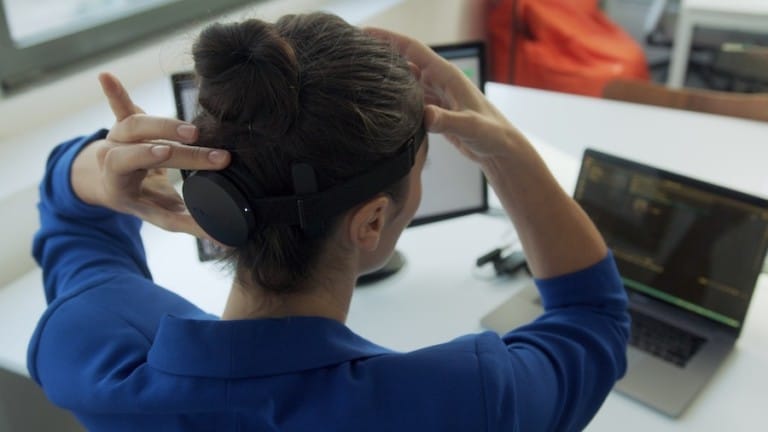The concept of brain-computer interfaces (BCI) is that they will do away entirely with the need for physical controllers such as joysticks, mouses and keyboards, touchscreens and steering wheels. While BCIs are already being used medically (in people with Parkinson’s or paralysis) they currently rely on experimental surgical implants. However, NextMind is one of a series of startups focusing on building a non-invasive neural interface.
Their device sits on the back of the head where it translates brain waves into data which, in turn, can be used to control software. It points the way to a future where many aspects of gaming and rides could be controlled without the need for physical controllers.
The device takes the standard EEG (electroencephalogram) which records electrical activity in the brain one step further. When used in hospitals, EEGs require gel but NextMind uses dry electrodes that simply require skin contact with the head.
The electrodes record neural activity primarily from the visual cortex at the back of the brain. It turns the signals into digital data which are processed on onto a computer from where a machine learning algorithm deciphers them, translating them into commands.
Although it may seem that the device is simply using eye-tracking, it actually senses the visual cortex itself – turning the thought of action into effect on the screen.
Is neural fast and accurate enough?
The NextMind neural interface dev kit runs on either Windows or Apple devices. It also contains a Steam VR demo. At the moment, the control is basic – simply activating flashing areas of the screen by focusing on them.
“The problem with some of these BCI devices is not whether they can become fast enough to enhance gameplay or control smart-home devices,” says Arielle Pardes, writing in Wired. “It’s whether anyone cares to.”
She cites the example of InteraXon, a Canadian startup, that made a device similar to NextMind’s but eventually gave up, as they felt it just wasn’t elegant enough to use.
Scott Stein, who tried out the dev kit for CNET, concedes the tech is in its infancy but believes it could signal the future:
“Right now, neural inputs feel like an imperfect attempt at creating an input, like algorithms searching for a way to do something I’d probably just do with a keyboard, a mouse or touchscreen instead,” he said. “But, that was how voice recognition felt, once. And hand tracking.”
Neural input tech on social
The impact of neural interface tech is most likely to be experienced first on social platforms or in the world of gaming, combined with other peripherals.
Andrew Bosworth, head of AR/VR on Facebook, believes it will first emerge on Facebook within the next three to five years, most likely in combination with smart glasses. However, he believes it will probably take five to ten years before the technology is robust enough to change the game:
“At first, it’s gonna be completely conventional and gimmicky,” he said, in an interview with CNET. “And then it’ll be kind of more profound, but it’ll still work inside of existing paradigms…using neural interfaces, for example, to operate a keypad or a touchpad that you can see. Eventually, we get to a really cool place, maybe in the 20-year timeframe, where…rather than intentions to motions, intentions to accomplish a goal are interpreted. When AI and neural interfaces come together…whoo, boy, that’s exciting to me.”
Facebook bought neurotech company CTRL-Labs in 2019.
Allowing humans to compete with AI
Last year, Elon Musk unveiled information on Neurolink, a chip that will allow people to stream music directly to their brains. He pointed out that the chip could also help people with brain diseases, and that it could potentially cure depression and addiction by retraining parts of the brain.
Ultimately the technology could help people compete with artificial intelligence. However Musk’s device relies on a physical implant – the process has been described as akin to laser eye surgery. While acknowledging that neural activity can be accessed using non-invasive tech, Neuralink insists the implants will be necessary.
“To access fine-scale information, you need to be close to the source…recording action potentials or voltage “spikes”, from individual neurons,” says Neuralink on its website. “Currently that can only be done by placing electrodes inside the brain.”
The possibilities are endless
NextMind firmly believes the future is non-invasive and that neuro-tech will change the way we think the world. “This is real,” said NextMind’s Sid Kouider, talking at Slush, a showcase for startups in Helsinki, “and the possibilities are endless.”
Last week, several new tech innovations were unveiled at CES 2021, including smart face masks, companion robots and more.













